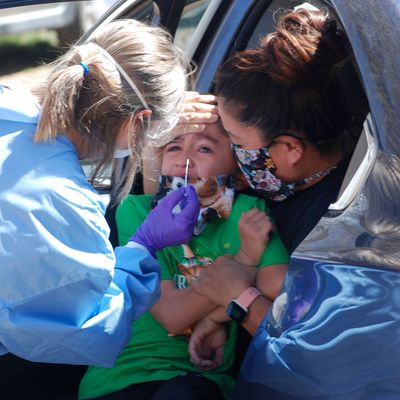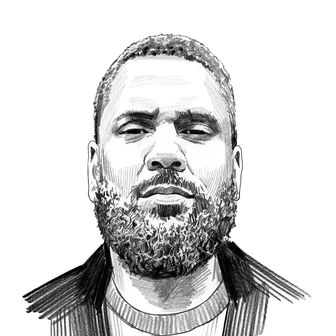
The Trump administration is slow-walking $8 billion in desperately needed pandemic aid to Native American tribes, many of whose lands have become coronavirus hot spots while enduring their worst economic crisis in decades. This was foreseeable; the president has spent decades telegraphing his enmity toward Native people and disregard for their concerns, even before he took office. It was a matter of time before a disaster of this magnitude brought it all to bear.
The latest funding delay stems from a mix of administrative ineptitude and legal wrangling. A month after Congress passed the CARES Act on March 27, which allocated relief money, tribal governments still hadn’t received a cent. (As of this writing, they still haven’t.) Several sued the federal government for the holdup, but a separate lawsuit was filed to resolve a related problem: the administration’s choice to include Alaska Native corporations among the entities that could receive funds. ANCs are not tribal governments, though some serve tribes by managing land and sharing governing responsibilities; the simplified backstory is that they were devised in the early 1970s to solidify tribal-land control in Alaska, in large part to make those lands easier for oil tycoons to plunder. (Several ANCs have gone on to profit from these arrangements.) But many Alaska Native tribes have their own governments, too, even if they weren’t federally recognized until the mid-1990s — much later than those in the lower 48. In some cases, this means that making ANCs eligible for pandemic dollars lets some tribes get money twice while others get less than they would otherwise, an outcome widely regarded as unfair.
The impact of fewer available funds for non-ANC tribal entities isn’t theoretical; the coronavirus and its economic impact have decimated tribal coffers that were already close to bone-dry from decades of underfunding. Tribal businesses have shuttered en masse, costing thousands of people their jobs and incomes. Overstretching aid would make matters worse. Allegations of federal profiteering complicate things further. Tara Sweeney, assistant secretary of Indian Affairs in the Interior Department, was vice-president of an ANC before joining the Trump administration, raising suspicion around her motives for insisting on their eligibility; several tribes have since called on her to resign. This discord was avoidable, as was the delay in disbursement. But the Trump administration’s proclivity for conflicts of interest and general incompetence, paired with the typical Republican disdain for public investment, may have rendered inevitable what happened instead — too little money, too late, and with the stench of a deal-sweetening payout for Trump officials hovering over it.
If this smacks of a deep disregard for Native people’s deteriorating plight and borderline hostility toward their interests, it’s partly because the president overseeing the process has adopted both as decades-long principles dating back to his days as a businessman. His well-documented feuds with Native tribes in the New York area when he was operating casinos found him trafficking in racist smear campaigns aimed at thwarting their commercial endeavors to benefit his own. A series of local ads in the 1990s opposing a new casino on St. Regis Mohawk tribal lands — claiming, among other things, that Native-run casinos bring violence, drug trafficking, and “broken homes” to unsuspecting communities — were revealed to have been bankrolled by Trump, who had rival interests and didn’t want the competition. This happened as Native American gaming was ascending as one of the country’s largest new sources of employment, according to the New York Times, as well as a crucial revenue stream for impoverished tribes; Trump’s efforts to undermine it prefaced a pattern of his privileging his self-interest over Native people’s capacity to self-preserve.
This habit followed him into his presidential campaign. Through much of his run, members of the Standing Rock Sioux tribe were protesting the extension of the Dakota Access oil pipeline near tribal lands in North Dakota. At issue was the project’s proposed route: Energy Transfer Partners, its constructor, planned to burrow it beneath the Missouri River, a water source for the tribe that many feared would become contaminated by leaks and spills. (Within months of its eventual completion, the pipeline had sprung several leaks and pumped more than 80 gallons of oil into the surrounding environment, affirming their fears.) But their entreaties failed to sway Trump, who was then among the pipeline’s investors; the CEO of Energy Transfer Partners had also donated more than $100,000 to his campaign, though his advisers assured the public that this had no bearing on the then-candidate’s decision to support its completion. You wouldn’t have known it by how quickly Trump acted once he got elected: Mere months after President Obama’s Army Corps of Engineers denied an easement that would’ve allowed the pipeline to move forward, delivering tribal protesters and their allies a hard-fought victory, the president brushed the Standing Rock Sioux aside and rammed it through.
Less targeted but equally insidious has been Trump’s willingness to forgo federal obligations to tribes to secure political advantage. Day-to-day operations on many Native American reservations rely on D.C. dollars, making them especially vulnerable to volatility on Pennsylvania Avenue. In January 2019, when Trump initiated the longest government shutdown in U.S. history to extort Congressional Democrats into paying for his border wall, thousands of federal workers went unpaid, and tribes were hit hard. His gambit failed, but Natives suffered anyway; snowstorms in Navajo country left roads blanketed and unplowed, leaving people trapped in their homes and unable to travel for water, groceries, or medicine. The Mescalero Apache reservation was left with one police officer to patrol an area the size of Houston, responding to multiple car wrecks and welfare checks. Sick Native elders weren’t able to contact the Indian Health Service to get referrals for follow-up doctor’s appointments. The Seattle Indian Health Board found itself mulling cuts to chemical-dependency treatment programs.
The pandemic has brought much of the same. In addition to the funding delay, the Trump administration abruptly revoked reservation status for Mashpee Wampanoag tribal lands in Massachusetts in late March, just as tribal members were scrambling to figure out how to best protect themselves from the coronavirus. His administration has been characteristically hands-off when tribes needed his help, even as they suffer disproportionately, a fact often exacerbated by tense relations with Trump’s state-level allies. The Navajo Nation has a higher rate of coronavirus infections than any state but New York and New Jersey, and Native Americans make up half of coronavirus deaths in New Mexico, despite being 11 percent of the population. In South Dakota, Republican Governor Kristi Noem is threatening to sue the Cheyenne River and Oglala Sioux tribes over roadblocks they’ve set up to screen travelers entering and exiting their reservations, which they’ve placed on lockdown.
If there was little doubt that Trump would fumble his handling of a national crisis this severe, there was even less that he’d reserve special disregard for Native Americans, who were already bound to be hit hard — on average, they’re more likely to be poor, lack adequate health-care access, and have preexisting medical conditions, like diabetes, that can transform a COVID-19 diagnosis into a death sentence. Compounding the devastation is how transparently Trump’s past behavior presaged it. Even if the specifics weren’t totally predictable, the general approach was never likely to be anything besides what it is, and he got elected anyway. Hundreds of deaths later and counting, Indian country now faces both the toll of a global pandemic and the callousness and cruelty of a U.S. president with a history of enmity toward their communities. That this outcome was foreseeable makes it no less harrowing. If anything, it makes it more characteristically American.






























